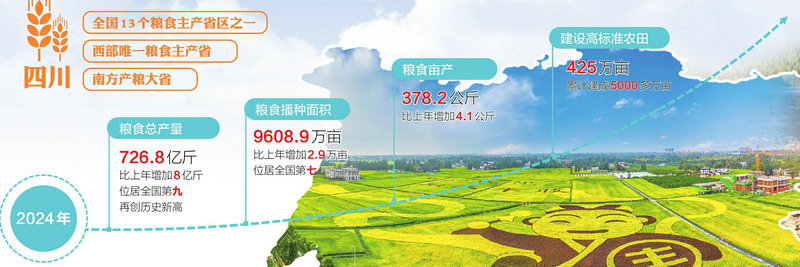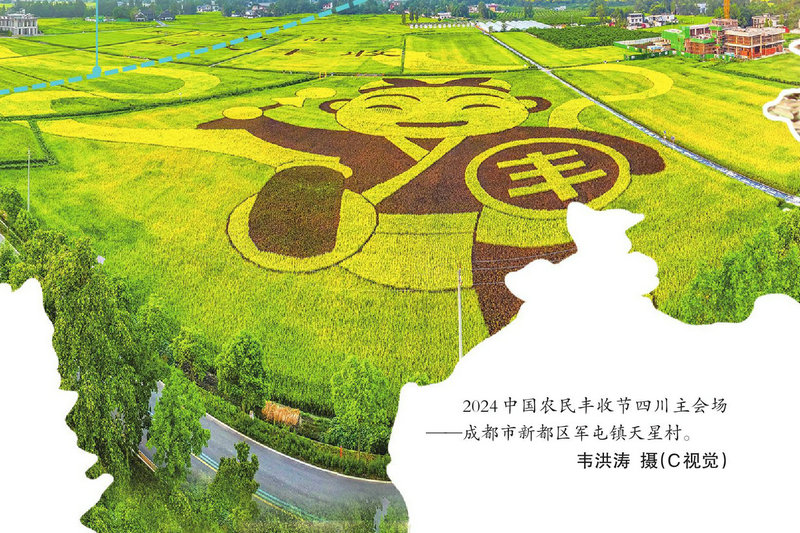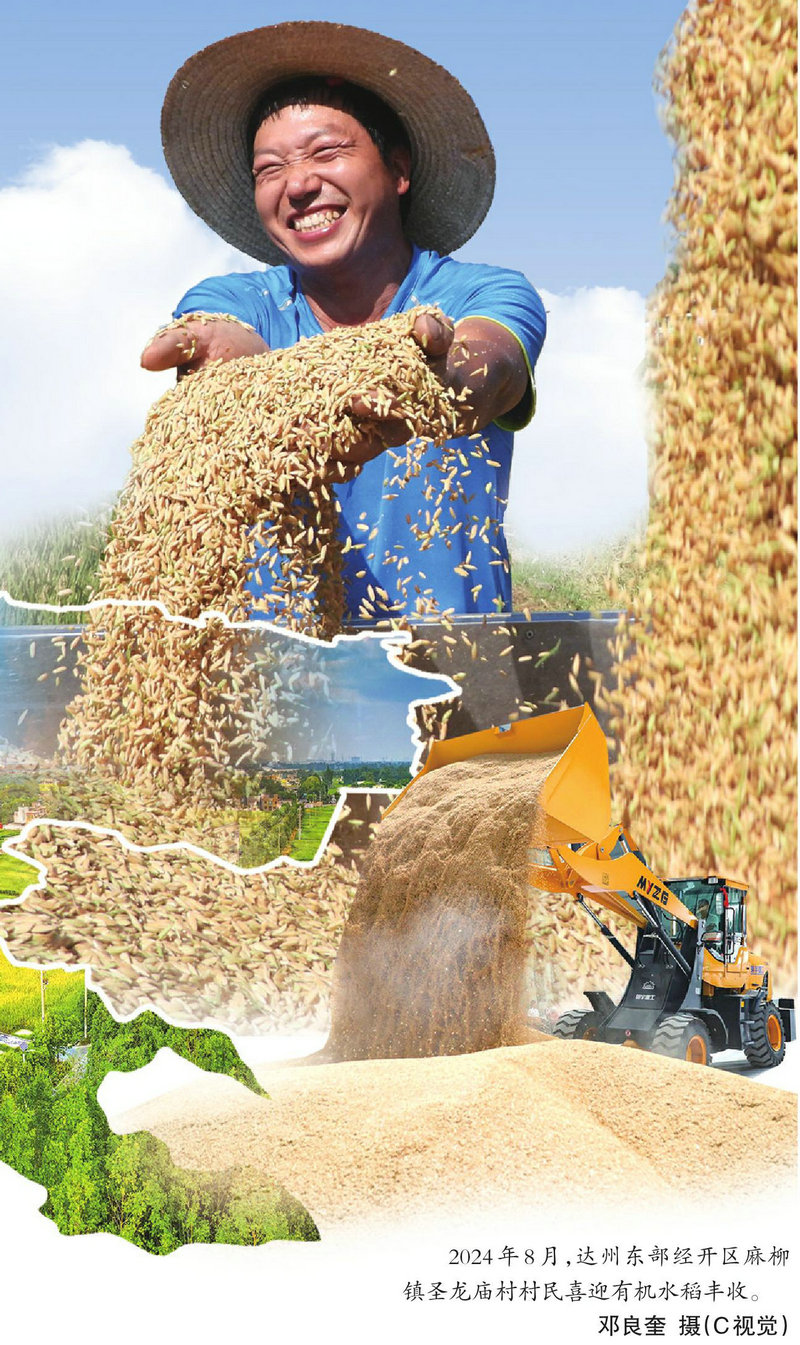What does the grain output of 72.68 billion catties mean to Sichuan |
| 时间:2025-07-16 07:49:15 访问量:1 |
□ Sichuan Daily all-media reporter Wang Chengdong In 2024, Sichuan's total grain output will reach 72.68 billion catties, an increase of 800 million catties over the previous year and a record high. How did the all-time high in food production come about? For Sichuan and even the whole country, what is the significance of this "historical high"? Looking forward to the new year, how should Sichuan steadily increase grain production? A hard-won all-time high The vast majority of abandoned cultivated land has completed the "rebirth", and the combination of "five good" has helped Sichuan achieve "three increases" In the past 2024, Sichuan has experienced natural disasters such as high temperatures and droughts. In an unfriendly external natural environment, how did Sichuan achieve high yields? The valley does not grow in the land. A steady increase in the sown area is the basis for a steady increase in grain production. At the beginning of last year, Sichuan decomposed and assigned the target task of grain sowing area to the grassroots level. Under the pressure layer by layer, the grain sowing area in Sichuan reached 96.089 million mu, an increase of 29,000 mu over the previous year, and the total area ranked seventh in the country. However, the key to increasing Sichuan's grain production is to increase production capacity per unit area. Since 2020, the province has continuously strengthened the reclamation and recultivation of abandoned land, and most of the abandoned cultivated land has completed the "rebirth", and the potential for increasing production by expanding planting is no longer large. How can I increase my yield? In the face of this systemic problem, Sichuan has played a "combination punch" of the integrated development of the "five good" of good land, good seeds, good opportunities, good laws and good systems. Fertile land refers to accelerating the construction of high-standard farmland that "guarantees income in drought and flood and is suitable for machine operation"; Improved seeds refer to high-yielding and high-quality seeds; Good opportunity refers to agricultural machinery and agricultural tools suitable for the terrain of Sichuan; Good law refers to agricultural technologies such as green and organic; The good system refers to the farming system and supporting policy system that can not only guarantee the income of farmers, but also ensure grain production. Last year, Sichuan completed the construction of 4.25 million mu of high-standard farmland, and the province has built more than 50 million mu of high-standard farmland, greatly improving the output capacity of cultivated land. With the help of the "Tianfu Opportunity" action, the comprehensive mechanization rate of crop cultivation and harvesting in the province increased by 6 percentage points last year. A total of 354 expert teams have been set up in the province, and 12,000 agricultural technicians have been set up to simultaneously promote farming models such as "rice-vegetable-vegetable" and "rice-medicine" in a large area. The average subsidy standard per mu for large grain growers in the plain area of Chengdu and the hilly and mountainous plateau areas has been increased to 100 yuan and 150 yuan respectively. Throughout the year, the province issued subsidies of more than 800 million yuan for large grain growers, an increase of nearly 60% year-on-year. In order to integrate and promote the high-yield and high-yield technology model, Sichuan launched the construction action of "Tianfu Granary, 100 Counties and 1000 Pieces" last year. At the same time, we will start the "three major competitions" of high-yield competition of 1,000 mu of grain and oil, ultra-high-yield competition of 100 mu of grain and oil, and high-yield competition of large-scale business entities, turn farmland into a high-yield competition, and demonstrate and drive the popularization and application of new technologies and new models. The "five good" support is strong, and last year Sichuan achieved the trend of "three increases" in grain sowing area, yield, and total output. Among them, the province's grain yield per mu was 378.2 kg, an increase of 4.1 kg or 1.1% over the previous year. Significant national ninth The only major grain-producing province in the west + a major grain-producing province in the south, which is precious from the overall point of view What do you think of Sichuan's grain output last year? Looking at the big picture, it is even more precious. Regarding Sichuan's position in ensuring national food security, a common saying is that Sichuan is one of the 13 major grain-producing provinces and autonomous regions in the country and the only major grain-producing province in the western region. But now, the phrase has increased again. The added phrase is: a large grain-producing province in the south. Statistics show that last year, Sichuan's grain output ranked ninth in the country. The provinces (regions) in front of Sichuan are: Heilongjiang, Henan, Shandong, Jilin, Anhui, Inner Mongolia, Hebei and Jiangsu. Last year, the top three provinces in the country in terms of grain output all exceeded the 100 billion jin mark. They are, Heilongjiang (160.03 billion catties), which has ranked first in the country for 15 consecutive years and exceeded 160 billion catties for the first time, Henan (134.39 billion catties), known as the "granary of the Central Plains", and Shandong (114.204 billion catties), which has exceeded 110 billion catties for four consecutive years. Shandong is the "goalkeeper" of the provinces (regions) with a grain output of 100 billion catties, and it has also formed a relatively obvious leading advantage for the provinces (regions) behind it. Last year, the provinces (regions) ranked fourth to eighth, the grain output was generally in the range of 70 billion jin to 90 billion jin. Among them, there are three provinces (regions) with a grain output of more than 80 billion catties, namely Jilin (85.32 billion catties), Anhui (83.69 billion catties) and Inner Mongolia (82.01 billion catties), and the gap between Shandong and Shandong is about 30 billion catties. In the range of 70 billion jin to 80 billion jin, they are Hebei (78.18 billion jin), Jiangsu (76.2 billion jin) and Sichuan (72.68 billion jin). Looking at the map of national grain production last year, it is not difficult to come up with the answer: Among the top nine provinces (autonomous regions) in national grain output last year, only Sichuan, Jiangsu, and Anhui were southern provinces. Sichuan is the only province in the west, and its importance is even more prominent. In other words, Sichuan's stable and bumper grain production has made a special contribution to the balance of production and marketing and the stability of grain supply among the country's grain regions. This further proves and explains why Sichuan can shoulder the important task of building a strategic base for the supply of important primary products in the country. Continue to jump up and touch the high gripper With the help of "yields per unit of lading," we will strive to increase the total grain output by more than 500 million catties this year The Central Rural Work Conference held in December last year emphasized the need to resolutely shoulder the important task of ensuring national food security, continue to enhance the supply guarantee capacity of grain and other important agricultural products, stabilize the grain sowing area, further promote the large-scale yield improvement of grain and oil crops, strengthen the construction of agricultural disaster prevention and mitigation capabilities, and ensure stable and bumper grain production. In line with the central government's deployment, "yielding per unit of production" is still the main starting point for Sichuan to achieve stable and increased grain production this year. Sichuan still has potential to be tapped. Because, Sichuan's output per unit area is not advantageous among the major grain-producing provinces. Last year, Hebei's grain yield per mu was 403.35 kilograms, Jilin's grain yield was 485.85 kilograms, Henan's grain yield was 415.7 kilograms, Shandong's grain yield was 452.51 kilograms, and Jiangsu's grain yield was 463.8 kilograms...... In horizontal comparison, Sichuan still has a lot of room for growth. Sichuan's yield is not as good as that of several other major grain-producing provinces, and the main factor is the planting pattern. Compared with the "wheat-corn" rotation in the Huang-Huai-Hai Plain and the "wheat-rice" rotation in the middle and lower reaches of the Yangtze River, Sichuan has inherent disadvantages. Because, as the largest rapeseed province in the country, Sichuan also shoulders the important task of ensuring the safety of the country's "oil bottles", and the province adopts the "rice-rape" rotation mode, sowing more than 2,200 acres of rapeseed all year round. In other words, other major grain-producing provinces can grow all grain in two seasons a year, while Sichuan mostly chooses to grow grain in the spring. However, the potential for increasing production in the spring is still not small. For example, last year, the coverage rate of improved varieties and the rate of technology in place just crossed the threshold of 95%. Therefore, with the help of the construction action of "Tianfu Granary, 100 Counties and 1000 Pieces", further accelerating the integrated development of "five good" is the most feasible plan for Sichuan to increase the total output. Previously, Sichuan proposed to increase the yield and strive to increase the total grain output of the province by more than 500 million catties this year. The Central Rural Work Conference held at the end of last year also deployed relevant work: improve the grain production support policy system, and start the implementation of inter-provincial horizontal interest compensation in grain production and marketing areas under the overall planning of the central government; We will improve the coordination mechanism for trade and production of agricultural products, and promote the maintenance of prices of grain and other important agricultural products at a reasonable level...... All kinds of favorable policies will also give new impetus to the increase in grain production. |
| 上一篇:In 2024, the Ministry of Agriculture and Rural Affairs will carry out a total of 3 routine monitoring of the quality and safety of national agricultural products, sampling 23,398 samples in 5 categories of vegetables, fruits, tea, livestock and poultry pr 下一篇:Our province released 50 agricultural leading varieties and 84 main agricultural technologies in 2025 |





